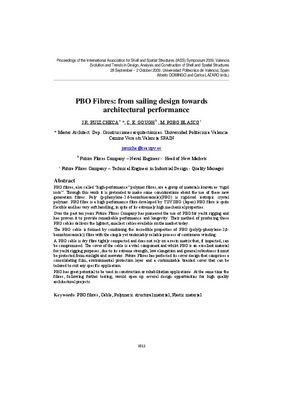JavaScript is disabled for your browser. Some features of this site may not work without it.
Buscar en RiuNet
Listar
Mi cuenta
Estadísticas
Ayuda RiuNet
Admin. UPV
PBO Fibres: from saliling design towards architectural performance
Mostrar el registro sencillo del ítem
Ficheros en el ítem
| dc.contributor.author | GOUGH, C. E.
|
|
| dc.contributor.author | Pobo Blasco, María
|
|
| dc.contributor.author | Ruiz Checa, José Ramón
|
|
| dc.contributor.editor | Domingo Cabo, Alberto
|
es_ES |
| dc.contributor.editor | Lázaro Fernández, Carlos Manuel
|
es_ES |
| dc.date.accessioned | 2009-12-18T10:53:07Z | |
| dc.date.available | 2009-12-18T10:53:07Z | |
| dc.date.issued | 2009-12-18T10:53:07Z | |
| dc.identifier.isbn | 978-84-8363-461-5 | |
| dc.identifier.uri | http://hdl.handle.net/10251/6706 | |
| dc.description | p. 3013-3023 | en_EN |
| dc.description.abstract | PBO fibres, also called "high-performance" polymer fibres, are a group of materials known as "rigid rods". Through this work it is pretended to make some considerations about the use of these new generation fibres. Poly (p-phenylene-2.6-benzobisoxazole)(PBO) is rigid-rod isotropic crystal polymer. PBO fibre is a high performance fibre developed by TOYOBO (Japan) PBO fibre is quite flexible and has very soft handling, in spite of its extremely high mechanical properties. Over the past ten years Future Fibres Company has pioneered the use of PBO for yacht rigging and has proven it to provide remarkable performance and longevity. Their method of producing these PBO cables delivers the lightest, smallest cables available on the market today. The PBO cable is formed by combining the incredible properties of PBO (poly(p-phenylene-2,6- benzobisoxazole)) fibre with the simple yet undeniably reliable process of continuous winding. A PBO cable is dry fibre tightly compacted and does not rely on a resin matrix that, if impacted, can be compromised. The cover of the cable is a vital component and whilst PBO is an excellent material for yacht rigging purposes, due to its extreme strength, low elongation and general robustness it must be protected from sunlight and seawater. Future Fibres has perfected its cover design that comprises a consolidating film, environmental protection layer and a customizable braided cover that can be tailored to suit any specific application. PBO has great potential to be used in construction or rehabilitation applications. At the same time the fibres, following further testing, would open up several design opportunities for high quality architectural projects. | en_EN |
| dc.language | Inglés | en_EN |
| dc.publisher | Editorial Universitat Politècnica de València | es_ES |
| dc.relation.ispartof | Symposium of the International Association for Shell and Spatial Structures (50th. 2009. Valencia). Evolution and Trends in Design, Analysis and Construction of Shell and Spatial Structures : Proceedings | en_EN |
| dc.rights | Reserva de todos los derechos | en_EN |
| dc.subject | Pbo fibres | en_EN |
| dc.subject | Cable | en_EN |
| dc.subject | Polymeric structural material | en_EN |
| dc.subject | Plastic material | en_EN |
| dc.title | PBO Fibres: from saliling design towards architectural performance | en_EN |
| dc.type | Comunicación en congreso | en_EN |
| dc.rights.accessRights | Abierto | es_ES |
| dc.description.bibliographicCitation | Gough, CE.; Pobo Blasco, M.; Ruiz Checa, JR. (2009). PBO Fibres: from saliling design towards architectural performance. Editorial Universitat Politècnica de València. http://hdl.handle.net/10251/6706 | es_ES |
| dc.relation.conferencename | Symposium of the International Association for Shell and Spatial Structures | es_ES |
| dc.relation.conferencedate | 2009 | es_ES |
| dc.relation.conferenceplace | Valencia | es_ES |






